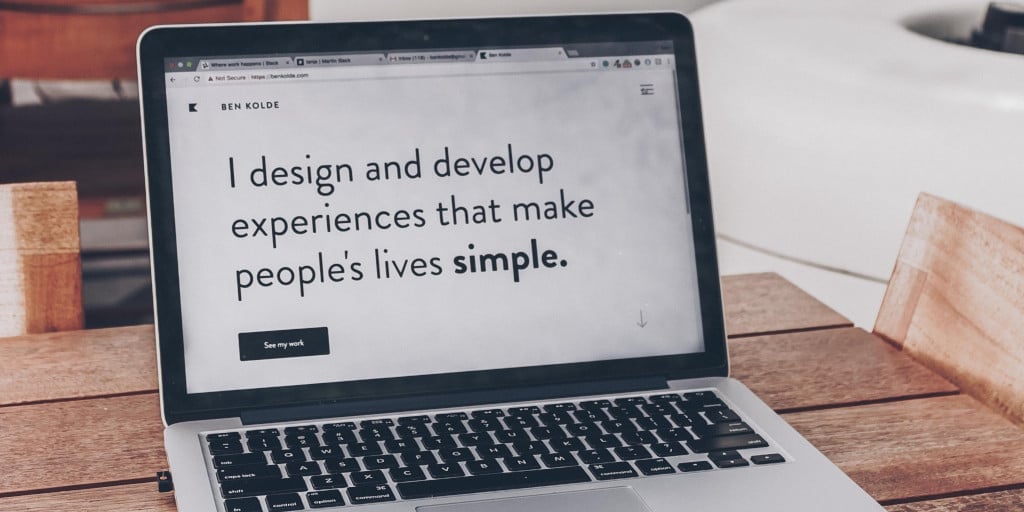
Jonathan Bond is a Process Street Staff Product Designer, Star Wars fan, and human problem solver. Reach him on Twitter @jrbond.
The path you actually take in life is often wildly different from the one you thought you’d take. I spent years undertaking a fine arts degree. However, after I graduated, I wanted to get my hands metaphorically dirty (and literally cleaner — goodbye, paint!) by going into graphic design.
Initially, I bounced between various agencies doing what you’d expect any freelance graphic designer to do: logos and websites. While it was interesting and paid the bills, there was a new buzzword on the block in 2010 that sounded even more exciting: UX.
![]()
“A user interface is like a joke.
If you have to explain it, it’s not that good.”
– Martin LeBlanc, CEO
User experience (UX) design is focused on the individual thoughts about a product or service a person might have. It takes into consideration qualitative data like the user’s emotions and attitudes towards a product, as well as the more practical elements like ease of use, efficiency, and so on.
The more I read about UX design, the more I liked what I read. I felt it fit my own design philosophy; I just connected with it. This was something I wanted to be involved in.
As luck would have it, a company that wanted someone to improve their app’s aesthetic hired me to be involved with that. I still didn’t have a clue what I was doing, but I kept reading and studying, and ten years later, I’m still doing that – now at Process Street.
This post will cover:
Product design at Process Street

I’m fairly new to the team at Process Street, but one of the things that drew me to the company was the intense focus on creating user value and making sure that the experience and needs of our customers are met in a way that’s helpful to them.
From the very beginning – from the most junior employee to CEO Vinay Patankar – everyone I spoke to was excited about our interactions with customers, and how the company could grow – which got me excited as well.
This focus on the customer carries over into our approach to user research.
UX research in simple terms
On the most basic level, the purpose of user research is to make sure you’re building for the needs of your customer. There’s no point spending time and resources on an idea you had in the shower one day if that idea doesn’t have any context.
An idea worth pursuing needs to have substance and a strong foundation in terms of the value to the customer to really get off the ground.
![]()
“Creating an interface is much like building a house: If you don’t get the foundations right, no amount of decorating can fix the resulting structure.” – Jef Raskin, designer
In that sense, user experience research (also called design research because, well, we design things based on the data) acts as a periscope. Individuals – or even teams – within a department can sometimes operate like they’re in a bunker; all they know is their surroundings and they don’t have any idea what’s going on around them.
Conducting design research sends that periscope up so you can get the lay of the land and see what’s going on, so you can make better decisions about moving forward.
Our design practices are centered around one question: What value are we bringing to the customer?
The traditional concept of UX research methods is that it’s about seeing how a completed project flies with your user base. You might picture a Madmen-esque research group sitting around a table while analysts in lab coats watch eagerly through a two-way mirror.
But it’s not like that.
Design research is just as much about identifying opportunities as correcting mistakes. Designers are still human, which means there is always a chance for human error. While we try to not get wrapped up in our own preferences as a point of reference, the fact is, we can’t think of everything.
It’s not uncommon for a user to make an off-hand comment, something like: That astromech droid really improves the starfighter’s maneuverability, especially when I’m switching out hyperspace route datachips.
Because they’re a small ship, starfighter navigation computers can only hold two programmable routes, but the astromech droid – which is already incorporated into the design – can store up to ten. There’s a perfect opportunity to implement a simple fix by connecting the droid to the navicomputer.

So, apologies to the design maestros in the room, but let me review some design research basics for our young padawans.
Fundamentals of UX research
UX research is a type of applied research that contains different categories of research:
- Generative: The purpose of this method is to generate data that will help designers establish a better understanding of what users might need or want. This is a useful method when you don’t yet know what you don’t know.
- Descriptive data: This method is a little more narrowed, but also involves a sense of uncertainty. In this case, as designers, we’re aware there’s a problem, but we may not know how to fix it yet. Descriptive research helps us learn what our possible options are.
- Evaluative: Evaluative incorporates methods like usability testing to determine what it is we’ve done and if it’s a working solution for our customers.
At Process Street, we’ve implemented a philosophy using a book called Shape Up. The concept behind “Shape Up” is introducing discipline into how ideas are shaped. Those ideas have to be founded on good reasoning, good understanding, and good data.
That data and understanding come from communicating with our users about what they need the product to do. This can be carried out in a number of ways: interactions with our customer success team, email surveys, video calls – any sort of user feedback gets factored into consideration when we think about the ideas we’re going to pursue.
With ideas built on that foundation, you can then shape them into pitches that are ready to be shown to the board of stakeholders. Their job is to look at these pitches and decide which is worth spending the next 4-6 weeks developing.

This is why discipline is so important: you can have a fantastic idea, but if you don’t have the data to show that, you won’t have a successful pitch. Even if the pitch is approved, a sense of discipline is necessary to make sure that idea improves the quality of your product.
For us, we concentrate on those shorter cycles; it’s not going to be a six-month project. We want to, through a short, focused effort, release something that has value to both the user and the company.
Collecting accurate data
In life, there are two types of people: those who love data so much they breathe it night and day, and those who run for the hills any time the word “metrics” comes up in conversation.
When it comes to the UX design process, user data is the blueberry to your pancake, the mac to your cheese, the pineapple to your peanut butter… You get the picture.
You can go about recruiting users to generate that data in a number of ways. These can be existing customers, or there are companies that facilitate recruiting so you get a population of already vetted users who have experience giving feedback and testing products.

Teachers have a hard road to travel, and COVID-19 lockdowns added a whole new level of pressure and complexity. Between having to upgrade their own tech skills and equipment overnight, teachers also had the added responsibility of ensuring their students’ skills and equipment were up to the task, as well.
While elearning is 40-60% more efficient in terms of time spent learning and retention, nearly 25% of students in rural or low-income households didn’t have access to remote learning resources at all. Teachers also had the added demand of managing not only student wellbeing under extreme stress, but the parents as well.
As a parent myself, the situation prompted me to think about the unexpected needs, in terms of tools and resources, remote teachers might now have, and how the usability of these apps could be improved or changed to ease some of the strain.
![]()
“To find ideas, find problems.
To find problems, talk to people.”
– Julie Zhuo, author
My method here was largely generative: I created a plan of questions I wanted to use. It’s important for data analysis to keep each interview as similar as possible. If you ask Person A a question you don’t ask Person B, you’re going to get inconsistent data, which is ultimately not helpful or useful.
With my list of questions, I used social media networks to recruit teachers and conduct these interviews, which I recorded and took notes on to preserve the data. Once I had my group of participants, I scheduled sessions with them to use the prototype I’d designed.
Since Process Street is a remote-first company – and most people are working remotely these days – these sessions happened over Zoom. The user would share their screen with me so I could see the different actions they took and how easy it was for them to accomplish various tasks.
This was important because you can’t solely look at what a person says when it comes to usability. They may be focused on a different element, or be excited about the concept, but unaware that they’re struggling to find a particular feature. Those are the things, as a designer and a researcher, that are really important to pay attention to.
The ideal scenario is when a user can perform a task without thinking about their actions; when the steps are so intuitive the user doesn’t notice them.
The details make the (UX) design
We recently changed the navigation of our website and app. In our usability study, we didn’t inform participants there’d been a change. Even our internal colleagues – some of our most extensive users – weren’t told so we could evaluate their responses as well. You don’t want to bias your research by drawing attention to the feature; the point is to see if they notice the change.
Instead, we asked our testing group to perform a common task and feedback on their responses.
If you think about a car, we all expect a standard arrangement of where the gear shift or the radio will be. While different models and brands will have slight variations, you’re not going to end up with a steering wheel in the backseat. In that situation, many users would probably find it difficult to adapt to such a drastic change.

The aim of good design is to tap into that familiarity. You don’t want your users to have to think about how they use your product; it should be intuitive. It should follow a layout they’ve seen so many times they can jump right in without long training sessions or sifting through weighty manuals.
With the Process Street app, we’d noticed that some of the button placement on the app’s dashboard wasn’t quite right; users were having difficulty locating some of the necessary controls.
Using that feedback, we created a new design intended to be more intuitive for our users. The goal with our study group was to see how they responded to the changes; specifically, we wanted to know if they noticed the difference.
![]()
“Good design is obvious. Great design is invisible.”
– Joe Sparano, graphic designer
For the most part, they adapted to the new design without even noticing. After a while, a few commented that the navigation was a little different, but the overall result was positive: we had improved usability.
When you’re making a bigger change – releasing a new feature, or overhauling an entire service – you may experience more pushback than we did in this situation. At the beginning, there will always be that very vocal group that complains about any change you make.
The difficult part of that scenario is sticking to your product roadmap. The temptation to immediately jump at addressing those initial concerns is strong, but you have to weather the storm for a while.
When we do something completely new or different, we document all of those initial complaints and concerns. After about a week, we evaluate whether or not those concerns are still present. Usually, by that time, the uproar has died down so we’re then able to identify the bugs that do need addressed.
You are not your user
UX design can’t be about your own ego. It’s not about you building a particular product; it’s about how that product will be used, how it will serve the user, and ultimately, how it will benefit the company.
![]()
“Keep going through the things that you like to do until you find something that you actually seem to be extremely good at.”
– George Lucas
My day-to-day involves a myriad of tasks, but conducting user research is my favorite part. I love to see the natural reaction of people to a new feature or design that I’ve built.
It can be difficult; it’s hard when users don’t like your design, or a project you’ve been working on is scrapped. In those cases, I have to be aware of my own bias.
For me – and for the rest of the team at Process Street – the real value is getting customers excited about what we’re doing, and knowing that we’re involved in making their tasks easier for them.
I love those WOW moments on a call when something works well for a customer. In that moment, you know that what you’ve done is going well, and that, even if it’s in a small way, you’ve improved someone’s life a little bit.
My path to UX design wasn’t straightforward – and certainly wasn’t where I thought I’d end up – but I kept following the things I liked to do. Each of those things – from fine art to graphic design to UX design – taught me skills I still use now, doing the thing I’m good at.
Share something surprising you’ve learned while using your own UX research methods. What’s the best WOW moment you’ve ever experienced?







 Workflows
Workflows Forms
Forms Data Sets
Data Sets Pages
Pages Process AI
Process AI Automations
Automations Analytics
Analytics Apps
Apps Integrations
Integrations
 Property management
Property management
 Human resources
Human resources
 Customer management
Customer management
 Information technology
Information technology



Leks Drakos
Leks Drakos, Ph.D. is a rogue academic with a PhD from the University of Kent (Paris and Canterbury). Research interests include HR, DEIA, contemporary culture, post-apocalyptica, and monster studies. Twitter: @leksikality [he/him]